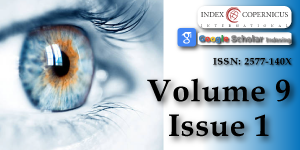Comparison of Visual Field Progression in Patients with Primary Open Angle Glaucoma and Pseudo Exfoliative Glaucoma
Main Article Content
Abstract
Objective: Comparison of visual field progression in patients with Primary Open-angle Glaucoma (POAG) and Pseudo Exfoliative Glaucoma (PEXG).
Methods and materials: This is a 2-year longitudinal prospective study including 60 glaucomatous eyes with VA CF ≥ 3 m, IOP ≥ 20 mmHg, CDR ≥ 0.6 and those with Shaffer’s grade 3 or above were categorized as POAG along with signs of Pseudo exfoliative material as PEXG.
Patients on anti-glaucoma medications and those who have undergone cataract and glaucoma surgeries are also included in this study. 24-2 visual field test was performed using Humphrey Field Analyzer & the progression was assessed based on 3 parameters- Mean Deviation (MD), Visual Field Index (VFI) & Guided Progression Analysis (GPA).
Results: The difference in MD & VFI was higher in PEXG (-5.77 dB) (10.88%) than in POAG (-1.56 dB) (7.17%) respectively & was significant statistically (t - test, p = < 0.001). The GPA showed fast progression in 53.30% of cases in PEXG, 13.30% in POAG (Chi-square, p = < 0.001) about 63.30% of POAG & 46.70% of PEXG showed slow- moderate progression, but 23.30% of POAG subjects had no progression.
Conclusion: Compared to POAG, the study showed that PEXG had frequent & faster visual field worsening. Therefore, PEXG patients require more stringent management & treatment than those with POAG.
Article Details
Copyright (c) 2025 Khaleel A, et al.

This work is licensed under a Creative Commons Attribution 4.0 International License.
Quigley HA. Number of people with glaucoma worldwide. Br J Ophthalmol. 1996;80(5):389-93. Available from: https://doi.org/10.1136/bjo.80.5.389
Shaffer RN, Becker B. Diagnosis and therapy of the glaucomas. 8th ed. San Francisco: Elsevier; 1961.
Quigley HA, Broman AT. The number of people with glaucoma worldwide in 2010 and 2020. Br J Ophthalmol. 2006;90(3):262-7. Available from: https://doi.org/10.1136/bjo.2005.081224
Tham YC, Li X, Wong TY, Quigley HA, Aung T, Cheng CY. Global prevalence of glaucoma and projections of glaucoma burden through 2040: a systematic review and meta-analysis. Ophthalmology. 2014;121(11):2081-90. Available from: https://doi.org/10.1016/j.ophtha.2014.05.013
Shields MB, Ritch R, Krupin T. Classification of the glaucomas. St. Louis: Mosby; 1996.
Vijaya L, George R, Paul PG, Baskaran M, Arvind H, Raju P, et al. Prevalence of open-angle glaucoma in a rural south Indian population. Invest Ophthalmol Vis Sci. 2005;46(12):4461-7. Available from: https://doi.org/10.1167/iovs.04-1529
American Academy of Ophthalmology. Primary open-angle glaucoma: Preferred practice pattern. San Francisco: The Academy; 2005.
Brandt JD. Corneal thickness in glaucoma screening, diagnosis, and management. Curr Opin Ophthalmol. 2004;15(2):85-9. Available from: https://doi.org/10.1097/00055735-200404000-00004
Ayala M. Comparison of visual field progression in newly diagnosed primary open-angle and exfoliation glaucoma patients in Sweden. BMC Ophthalmol [Internet]. 2020;20(1):322. Available from: https://doi.org/10.1186/s12886-020-01592-w
Tarkkanen AHA, Kivelä TT. Comparison of primary open-angle glaucoma and exfoliation glaucoma at diagnosis. Eur J Ophthalmol. 2015;25(2):137-9. Available from: https://doi.org/10.5301/ejo.5000516
Tielsch JM, Sommer A, Katz J, Royall RM, Quigley HA, Javitt J. Racial variations in the prevalence of primary open-angle glaucoma. The Baltimore Eye Survey. JAMA. 1991;266(3):369-74. Available from: https://pubmed.ncbi.nlm.nih.gov/2056646/
Klein BE, Klein R, Sponsel WE, Franke T, Cantor LB, Martone J, et al. Prevalence of glaucoma. The Beaver Dam Eye Study. Ophthalmology. 1992;99(10):1499-504. Available from: https://doi.org/10.1016/s0161-6420(92)31774-9
Leibowitz HM, Krueger DE, Maunder LR, Milton RC, Kini MM, Kahn HA, et al. The Framingham Eye Study monograph: An ophthalmological and epidemiological study of cataract, glaucoma, diabetic retinopathy, macular degeneration, and visual acuity in a general population of 2631 adults, 1973–1975. Surv Ophthalmol. 1980;24(Suppl):335-610. Available from: https://pubmed.ncbi.nlm.nih.gov/7444756/
Mitchell P, Smith W, Attebo K, Healey PR. Prevalence of open-angle glaucoma in Australia. The Blue Mountains Eye Study. Ophthalmology. 1996;103(10):1661-9. Available from: https://doi.org/10.1016/s0161-6420(96)30449-1
Åström S, Stenlund H, Lindén C. Incidence and prevalence of pseudoexfoliations and open-angle glaucoma in northern Sweden: II. Results after 21 years of follow-up. Acta Ophthalmol Scand. 2007;85(8):832-7. Available from: https://doi.org/10.1111/j.1600-0420.2007.00980.x
Musch DC, Shimizu T, Niziol LM, Gillespie BW, Cashwell LF, Lichter PR. Clinical characteristics of newly diagnosed primary, pigmentary, and pseudoexfoliative open-angle glaucoma in the Collaborative Initial Glaucoma Treatment Study. Br J Ophthalmol. 2012;96(9):1180-4. Available from: https://doi.org/10.1136/bjophthalmol-2012-301820
Puska PM. Unilateral exfoliation syndrome: conversion to bilateral exfoliation and to glaucoma: a prospective 10-year follow-up study. J Glaucoma. 2002;11(6):517-24. Available from: https://doi.org/10.1097/00061198-200212000-00012
Hammer T, Schlotzer-Schrehardt U, Naumann GO. Unilateral or asymmetric pseudoexfoliation syndrome? An ultrastructural study. Arch Ophthalmol. 2001;119(7):1023-31. Available from: https://doi.org/10.1001/archopht.119.7.1023
Ahrlich KG, De Moraes CG, Teng CC, Prata TS, Tello C, Ritch R, et al. Visual field progression differences between normal-tension and exfoliative high-tension glaucoma. Invest Ophthalmol Vis Sci. 2010;51(3):1458-63. Available from: https://doi.org/10.1167/iovs.09-3806
Kocaturk T, Bekmez S, Katranci M, Cakmak H, Dayanir V. Long term results of visual field progression analysis in open angle glaucoma patients under treatment. Open Ophthalmol J. 2015;9:116-20. Available from: https://doi.org/10.2174/1874364101509010116
Leske MC, Heijl A, Hyman L, Bengtsson B, Dong L, Yang Z; EMGT Group. Predictors of long-term progression in the Early Manifest Glaucoma Trial. Ophthalmology. 2007;114(11):1965-72. Available from: https://doi.org/10.1016/j.ophtha.2007.03.016
Heijl A, Bengtsson B, Hyman L, Leske MC. Natural history of open-angle glaucoma. Ophthalmology. 2009;116(12):2271-6. Available from: https://doi.org/10.1016/j.ophtha.2009.06.042
Kim JH, Rabiolo A, Morales E, Yu F, Afifi AA, Nouri-Mahdavi K, et al. Risk factors for fast visual field progression in glaucoma. Am J Ophthalmol. 2019;207:268-78. Available from: https://doi.org/10.1016/j.ajo.2019.06.019
De Moraes CG, Prata TS, Tello C, Ritch R, Liebmann JM. Glaucoma with early visual field loss affecting both hemifields and the risk of disease progression. Arch Ophthalmol. 2009;127(9):1129-34. Available from: https://doi.org/10.1001/archophthalmol.2009.165
Heijl A, Leske MC, Bengtsson B, Hussein M; Early Manifest Glaucoma Trial Group. Measuring visual field progression in the Early Manifest Glaucoma Trial. Acta Ophthalmol Scand. 2003;81(3):286-93. Available from: https://doi.org/10.1034/j.1600-0420.2003.00070.x
Bengtsson B, Lindgren A, Heijl A, Lindgren G, Asman P, Patella M. Perimetric probability maps to separate change caused by glaucoma from that caused by cataract. Acta Ophthalmol Scand. 1997;75(2):184-8. Available from: https://doi.org/10.1111/j.1600-0420.1997.tb00121.x
Arnalich-Montiel F, Casas-Llera P, Munoz-Negrete FJ, Rebolleda G. Performance of glaucoma progression analysis software in a glaucoma population. Graefes Arch Clin Exp Ophthalmol. 2009;247(3):391-7. Available from: https://doi.org/10.1007/s00417-008-0986-1
Wilkins M, Fitzke F, Khaw P. Pointwise linear progression criteria and the detection of visual field change in a glaucoma trial. Eye (Lond). 2006;20(1):98-106. Available from: https://doi.org/10.1038/sj.eye.6701781

